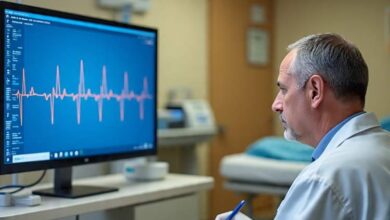5 Powerful Facts About Rigor Mortis Every Nurse Should Understand (Updated 2026))


What Is Rigor Mortis? A Breakdown of Its Process and Mechanism
Rigor mortis is a critical physiological process that occurs within hours after death, marked by the stiffening of skeletal muscles. It is one of the earliest recognizable signs of death and plays an essential role in postmortem assessments. Rigor mortis can be manually evaluated by attempting to move or extend the joints—this is commonly done during autopsies or postmortem care to estimate time of death.
The onset of rigor mortis usually begins in smaller muscle groups, particularly those in the hands, eyelids, and facial area. These muscles typically become rigid within three to four hours after death. In some cases, this early muscle stiffening can cause the face to appear distorted, such as with open eyes or a grimace. This effect is the result of rigor mortis-induced fixation and not a true reflection of the person’s final expression. As rigor mortis progresses, larger muscle groups—including those in the limbs and torso—stiffen, with full-body rigidity generally occurring around 12 hours postmortem.
Cause and Mechanism of Rigor Mortis
The cause of rigor mortis lies in the body’s cellular response to the cessation of oxygen following death. When respiration and circulation stop, the body can no longer produce adenosine triphosphate (ATP)—the primary energy source for cellular functions. ATP is especially vital in muscle contraction and relaxation. Under normal conditions, ATP allows myosin filaments in the muscles to detach from actin filaments after contraction. However, after death and in the absence of ATP, myosin remains tightly bound to actin, resulting in sustained muscle contraction. This chemical lock leads to the stiffness characteristic of rigor mortis.
As rigor mortis sets in, other chemical processes also take place. Without oxygen, cells shift from aerobic to anaerobic metabolism, leading to the production of lactic acid. The accumulation of lactic acid lowers the pH level inside muscle cells, which further contributes to muscle rigidity. Additionally, calcium ions begin to leak into the sarcomeres—where actin and myosin filaments are located—causing further contraction and solidifying the effects of rigor mortis.
The interplay of ATP depletion, lactic acid buildup, calcium influx, and pH drop all work together to initiate and sustain rigor mortis. These factors make rigor mortis a complex but predictable postmortem change that is essential to understand in nursing, forensic, and medical fields.

Stages of Rigor Mortis and Its Forensic Importance
The development of rigor mortis follows a well-defined pattern, progressing through six distinct stages: absent, minimal, moderate, advanced, complete, and passed. These stages reflect the gradual onset and resolution of muscle stiffness after death.
In the absent stage, the body is fully relaxed. Muscles are soft, and limbs can easily be repositioned. As rigor mortis begins to take effect, it enters the minimal stage, where slight stiffness is noticed, typically starting in the smaller muscles of the face and hands. In the moderate and advanced stages, stiffness spreads to larger muscle groups, limiting joint movement and resulting in fixed positioning of the limbs. By the complete stage, the entire body is rigid, and repositioning is extremely difficult without causing tissue damage. Eventually, rigor mortis transitions to the passed stage, when the stiffness starts to fade due to tissue breakdown, signaling the onset of decomposition.
Generally, rigor mortis reaches the passed stage around 36 to 48 hours after death. However, this timeline can vary depending on several influencing factors. These include the individual’s muscle mass, physical fitness, ambient temperature, body temperature at the time of death, and underlying conditions such as infections, seizures, or substance use. A person with low ATP levels at the time of death—caused by exertion, fever, or convulsions—may enter rigor mortis earlier than expected.
Rigor Mortis in Forensic Investigations
In forensic science, rigor mortis plays a vital role in helping determine the estimated time of death. Because the progression of rigor mortis is relatively predictable under normal conditions, forensic investigators can examine the stage of stiffness to establish a postmortem interval.
Additionally, rigor mortis is used to assess whether a body has been moved or tampered with after death. Typically, the body retains the same position it was in at the moment rigor mortis set in. If the body’s position contradicts the level of muscle stiffness—for instance, stiff limbs arranged unnaturally—it may indicate that the body was disturbed after death.
Understanding the stages of rigor mortis and their forensic significance is crucial in nursing, pathology, and criminal investigations. It helps professionals make informed decisions, whether in documenting death, reporting unusual findings, or assisting law enforcement.
How Long Does It Take for Rigor Mortis to Set In?

Rigor mortis typically begins within 2 to 6 hours after death, first appearing in the small muscles of the face, jaw, and hands. These muscles are the most sensitive to postmortem biochemical changes, making them the earliest indicators of the onset of rigor mortis. As the process continues, rigor mortis gradually spreads to larger muscle groups such as the arms, legs, and trunk.
The defining feature of rigor mortis is muscle stiffening, which results from the lack of oxygen after death. Once breathing stops, oxygen is no longer delivered to the body’s tissues, halting aerobic respiration. This leads to the rapid depletion of adenosine triphosphate (ATP)—a vital molecule required for muscle relaxation. Without ATP, myosin filaments remain tightly bound to actin filaments, causing the muscles to lock into a contracted position and giving rise to the rigid state known as rigor mortis.
As ATP levels drop further in the hours after death, rigor mortis advances throughout the body. The condition usually reaches its peak stiffness around 12 hours postmortem. At this point, the entire body is rigid and difficult to reposition. However, the rate at which rigor mortis develops and peaks can vary significantly based on multiple factors. These include the individual’s muscle mass, physical fitness, ATP availability at the time of death, and external conditions such as ambient temperature, humidity, and cause of death.
In cooler environments, rigor mortis may develop more slowly, while warmer temperatures can accelerate the process. Similarly, individuals who were physically active or experienced seizures before death may exhibit faster onset of rigor mortis due to preexisting ATP depletion.
For nurses, understanding these variables is essential during postmortem assessments, as the stage and distribution of rigor mortis can provide vital clues about the time of death, body positioning, and overall postmortem timeline.
Rigor mortis is a vital postmortem process that reveals crucial information about the time and circumstances of death. This stage of muscle stiffening typically begins within 2 to 6 hours after death and progresses based on several physiological and environmental factors. In cooler environments, rigor mortis may appear more slowly, while warmer temperatures accelerate its onset. Likewise, individuals with low ATP levels—often caused by intense physical activity, seizures, or underlying illness—may experience a faster onset of rigor mortis.
For nurses, healthcare professionals, and forensic teams, understanding the timing and distribution of rigor mortis is essential during postmortem assessments. It helps determine if the body has been moved, estimate the time of death, and observe any inconsistencies in physical findings. This knowledge not only enhances clinical accuracy but also strengthens forensic investigations. Whether in a hospital setting or a medicolegal environment, mastering the variables that affect rigor mortis is a must-have skill for anyone involved in end-of-life care.
Key Considerations in Postmortem Muscle Stiffening
Muscle stiffening after death, commonly referred to as rigor mortis, is a medically significant postmortem change that offers valuable insights during post-death care and forensic investigations. This temporary rigidity results from chemical changes in the muscles, and it plays a vital role in estimating time of death and guiding respectful handling of the deceased.
The process typically begins within two to six hours after death, starting in smaller muscles—such as those around the face and hands—before gradually progressing to the larger muscle groups in the limbs and torso. Maximum stiffness usually develops around 12 hours postmortem and may persist for up to 24 additional hours before gradually resolving. The entire cycle can last between 24 and 48 hours, depending on a range of internal and external factors.
Temperature is a major influence on the onset and duration of muscle stiffening. In colder environments, the process slows down significantly, while heat tends to accelerate it. High ambient temperatures can cause rigidity to appear more quickly, whereas low temperatures may delay the onset and prolong its duration. Humidity, air circulation, and clothing may also influence how fast the body cools and how quickly changes in the muscles occur.
Pre-existing physical conditions and activities prior to death also affect the timeline. For example, individuals who experienced physical exertion, convulsions, or trauma shortly before passing often show earlier signs of stiffness. This is due to the depletion of adenosine triphosphate (ATP), the energy molecule that allows muscle fibers to relax. When ATP runs out, muscle fibers remain locked in a contracted state, initiating the stiffening process more rapidly.
It’s important to differentiate normal postmortem rigidity from other forms of muscle tension that may occur immediately after death. Cadaveric spasm, which causes sudden and permanent tightening in specific muscles, is different and may be associated with violent deaths or extreme emotional states. Identifying which type of muscle change is present can influence both clinical documentation and forensic interpretation.
In clinical practice, documenting muscle stiffness includes noting its location, intensity, and whether it’s symmetrical. An even distribution is typical, while irregular stiffening could signal certain disease processes or external interference. If the body presents with stiffness inconsistent with expected patterns or appears abnormally soft beyond the typical time window, this may warrant further investigation into environmental conditions or medications used prior to death.
When providing postmortem care, healthcare professionals should position the body before muscle rigidity begins. This makes repositioning easier and ensures the deceased is displayed in a respectful and natural state. If repositioning becomes necessary after the onset of stiffness, extra care is required to avoid damaging soft tissues or causing injury during movement. Proper documentation of any physical resistance or complications is essential for transparency and professional accountability.
Certain health conditions can alter the usual timeline. Infections, fevers, and metabolic imbalances may either hasten or delay muscular changes. In palliative care settings, the care team may already be aware of conditions that could impact this process, helping them better anticipate how the body will respond after death. Similarly, drug use—especially sedatives or neuromuscular blockers—can influence the timing and intensity of postmortem muscle changes.
In forensic cases, identifying the timing and distribution of muscle rigidity is especially valuable. Investigators may use it to estimate when death occurred or whether the body was moved after death. If the body exhibits full-body stiffness in a position that doesn’t match the surrounding scene, it could suggest postmortem manipulation. Such details are often documented carefully to assist in building an accurate timeline or legal case.
This post-death process is also temporary. After reaching its peak, enzymes and bacteria begin to break down muscle fibers. This breakdown eventually softens the tissues again, ushering in the next phase of postmortem change—decomposition. Recognizing when stiffness starts to resolve is as important as identifying when it begins, particularly for investigators or those preparing the body for final arrangements.
For nurses and end-of-life caregivers, understanding muscle stiffening is not just about identifying physical changes—it’s also about delivering compassionate care. Recognizing the stages of postmortem transformation allows caregivers to manage the body with dignity, answer questions from grieving families, and anticipate how quickly further changes may occur. Education and communication are key in helping loved ones navigate the experience with less uncertainty.
From a forensic and clinical perspective, appreciating the complexity of this process enhances professional practice. By integrating knowledge of timing, influencing factors, and physiological mechanisms, practitioners are better equipped to make informed decisions, whether in acute care, hospice, or investigative environments.
Summary
Understanding the stages of muscle rigidity after death is essential for providing accurate, respectful, and informed care. Influencing factors such as temperature, physical exertion, and underlying health conditions all play a role in the timeline. Accurate documentation and sensitive handling of the body are crucial, especially when stiffness is used to assess postmortem intervals or body positioning. Healthcare and forensic professionals should be familiar with this process to support dignified care, assist in legal assessments, and educate families during a time of loss.





